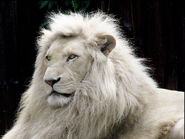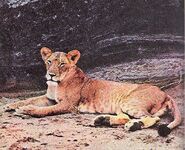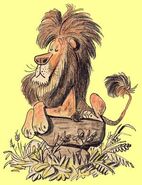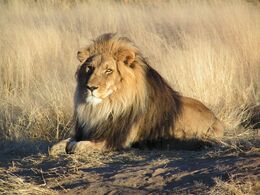
Male Lion in Nambia
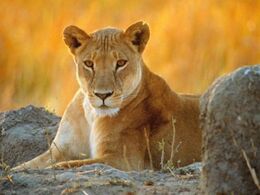
Female Lion (Lioness)
The lion (Panthera
leo) is one of the five big cats in the genus Panthera and a member of the family Felidae. The commonly used term African lion collectively denotes the several subspecies found in Africa. With some males exceeding 250 kg (550 lb) in weight, it is the second-largest living cat after the tiger. Lions are the only cats that live in groups, which are called prides. Prides are family units that may include up to three males, a dozen or so females, and their young. All of a pride's lionesses are related, and female cubs typically stay with the group as they age. Young males eventually leave and establish their own prides by taking over a group headed by another male. In the wild, males seldom live longer than 10 to 14 years, as injuries sustained from continual fighting with rival males greatly reduce their longevity. In captivity they can live more than 20 years. They typically inhabit savanna and grassland, although they may take to bush and forest. Lions are unusually social compared to other cats. A pride of lions consists of related females and offspring and a small number of adult males. Groups of female lions typically hunt together, preying mostly on large ungulates. Lions are apex and keystone predators, although they are also expert scavengers obtaining over 50 percent of their food by scavenging as opportunity allows. While lions do not typically hunt humans, some have. Sleeping mainly during the day, lions are active primarily at night (nocturnal), although sometimes at twilight (crepuscular).
Highly distinctive, the male lion is easily recognised by its mane, and its face is one of the most widely recognised animal symbols in human culture. Depictions have existed from the Upper Paleolithic period, with carvings and paintings from the Lascaux and Chauvet Caves, through virtually all ancient and medieval cultures where they once occurred. It has been extensively depicted in sculptures, in paintings, on national flags, and in contemporary films and literature. Lions have been kept in menageries since the time of the Roman Empire, and have been a key species sought for exhibition in zoos over the world since the late eighteenth century. Zoos are cooperating worldwide in breeding programs for the endangered Asiatic subspecies.
Lion Prides and Hunting
Only male lions boast manes, the impressive fringe of long hair that encircles their heads. Males defend the pride's territory, which may include some 100 square miles (259 square kilometers) of grasslands, scrub, or open woodlands. These intimidating animals mark the area with urine, roar menacingly to warn intruders, and chase off animals that encroach on their turf.
Female lions are the pride's primary hunters. They often work together to prey upon antelopes, zebras, wildebeest, and other large animals of the open grasslands. Many of these animals are faster than lions, so teamwork pays off. After the hunt, the group effort often degenerates to squabbling over the sharing of the kill, with cubs at the bottom of the pecking order. Young lions do not help to hunt until they are about a year old. Lions will hunt alone if the opportunity presents itself, and they also steal kills from hyenas or wild dogs.
Conservation
Lions have been celebrated throughout history for their courage and strength. They once roamed most of Africa and parts of Asia and Europe. Today they are found only in parts of sub-Saharan Africa, except for one very small population of Asian lions that survives in India's Gir Forest.



